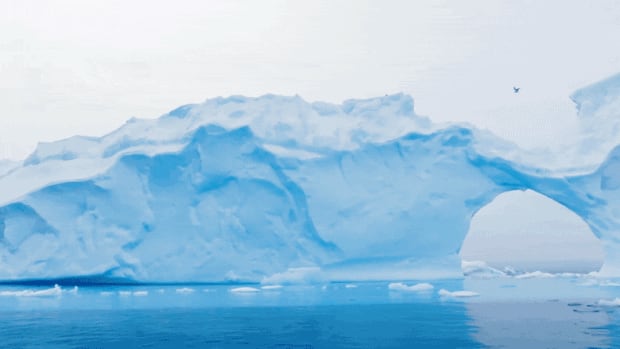
Our planet is changing. So is our journalism. Keep up with the latest news on our Climate and Environment page.
Sign up here to get this newsletter in your inbox every Thursday.
This week:
- Can an image of frozen penguin chicks spark climate action?
- The Big Picture: Think it was a quiet year for wildfires? Think again
- A therapist offers strategies for dealing with climate anxiety, including her own
Can an image of frozen penguin chicks spark climate action?
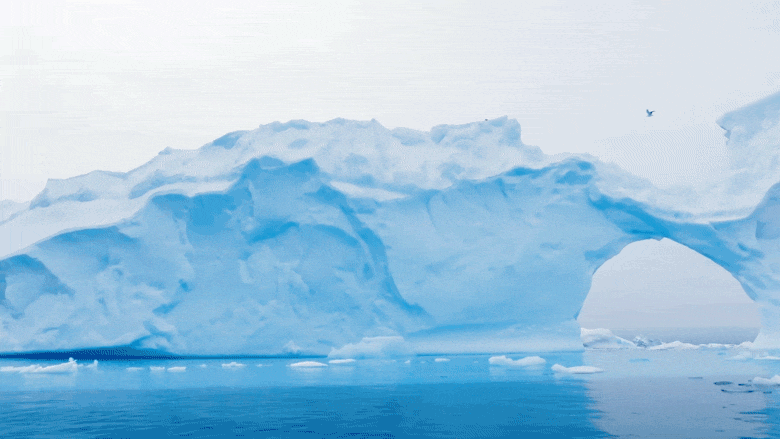
When photographer Neil Ever Osborne arrived in Antarctica in November 2023, he knew he’d be a first-hand witness to the effects of climate change. Already satellite imagery had revealed it was the site of a catastrophic emperor penguin breeding failure.
The penguins, which need sea ice connected to land to breed and raise their chicks, were suffering a breeding failure because that same ice was melting due to climate change. In 2022, Antarctic sea ice reached record low levels. As a result, fewer and fewer penguin chicks were born in those colonies.
“What’s happening to this particular colony might be sort of a barometer for what might happen if Antarctica continues to see warming temperatures,” said Osborne.
What Osborne saw next was hard to ignore. There, entombed in the ice, were lifeless penguin chicks. Peter Fretwell, lead scientist for the British Antarctic Survey, said that the “chicks likely died due to hypothermia after falling into melt pools.”
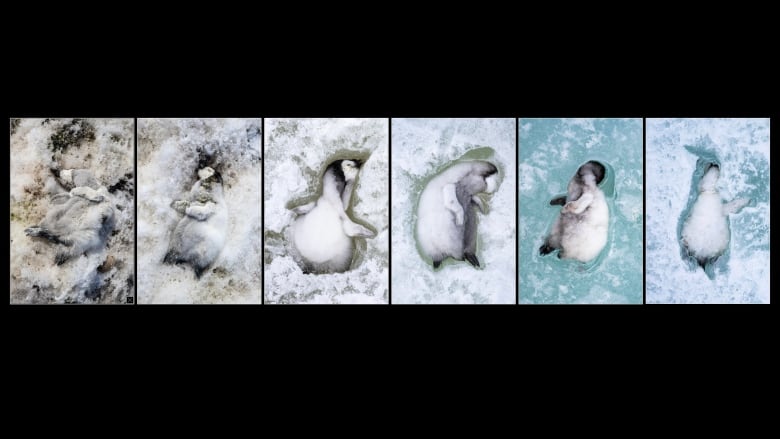
These melt pools form around the colonies every time the temperature rises above 0 C. The chicks fall in and drown. When the temperature drops again, the pools solidify, trapping their bodies. Osborne saw dozens chicks like this. The further he walked, the more he saw. He captured these images to use as part of his upcoming exhibition at Berenson Fine Art Gallery in Toronto.
“This particular series has become quite haunting in some ways,” Osborne said. “But also a way to just remind everybody that nowhere on planet Earth will remain untouched by a warming world.”
Osborne wants his exhibition of Antarctic photographs to help spark conversation and action about global warming, and encourage countries to protect the land, sea and wildlife on and surrounding Antarctica.
Osborne’s wish is that this exhibition motivates people to sign a petition to protect Antarctic ecosystems, which he hopes will influence decision-makers at an upcoming meeting of the Commission for the Conservation of Antarctic Marine Living Resources to establish marine protected areas in the Southern Ocean.
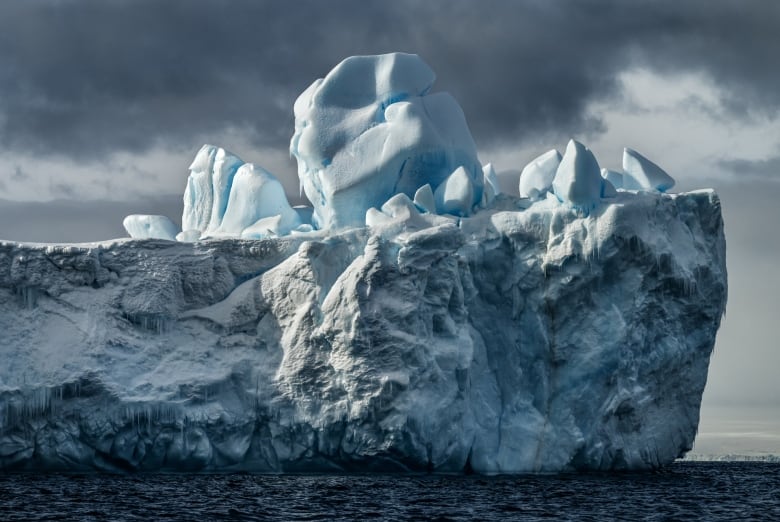
Photography isn’t the only art form sparking climate action. Alvin Erasga Tolentino, the artistic director of Erasga Dance Company in Vancouver, spent years wrestling with images of typhoon flooding in his native Philippines, and now grapples with the raging wildfires of British Columbia. To illustrate his frustration, Alvin turned to dance.
“That’s the power of dance,” Tolentino said. “It’s not about verbal. It’s not about words. It’s about the spiritual as well that needs to be expressed through movements.”
Now Tolentino, along with choreographers Naishi Wang and Alvin Collantes, has produced a new show about the climate crisis. All three choreographers believe there’s still hope. Similar to Osborne, they believe that change starts with conversation and reflecting on the power of collective action.
“The ripple effect is really together,” Tolentino said. “We’re not one performing, but together performing as a community.”
Osborne’s exhibition Antarctica: Ice & Shadows runs from Sept. 28 to Oct. 12 at the Berenson Fine Art Gallery in Toronto. Tolentino’s What On Earth will take place Sept. 18 to 20 at the Roundhouse Community Arts Centre in Vancouver.
— Dannielle Piper

Old issues of What on Earth? are here. The CBC News climate page is here.
Check out our podcast and radio show. In our newest episode: The future may be green for drillers looking for work outside the oil industry. Demand is growing for geothermal heat pumps and that requires people with the skills to drill deep below ground and harness energy to heat and cool homes. It turns out drilling is a sustainable job, in more ways than one.
What On Earth24:28‘Drill, baby, drill’ … for green energy
What On Earth drops new podcast episodes every Wednesday and Saturday. You can find them on your favourite podcast app, or on demand at CBC Listen. The radio show airs Sundays at 11 a.m., 11:30 a.m. in Newfoundland and Labrador.
Reader feedback
In response to last week’s story on fighting wildfires becoming a year-round job, Pam Garratt Dunlop wrote: “There’s been much recent description of cultural and prescribed burns. I wish there would be an article and/or a database that would make the Indigenous and other information on this topic available to all of us… Similarly, I know there’s a great deal of information out west, if one can but find it, regarding using drip irrigation/soaker hoses to protect roofs and other surfaces during times of potential wildfires. I know one can also use such systems for cooling roofs. Details? Resources?”
There is definitely a lot of valuable Indigenous knowledge and practices concerning fire that are starting to be recognized. We’re not sure there’s a database, but CBC has published quite a few articles on this recently, including this beautiful in-depth piece from our colleagues in B.C. earlier this year. Regarding sprinklers to protect and cool rooftops, that’s an interesting topic. We’re not able to explore it in detail for now, but Fire Smart BC does have a fact sheet about it.
Write us at [email protected].




The Big Picture: Think it was a quiet year for wildfires? Think again
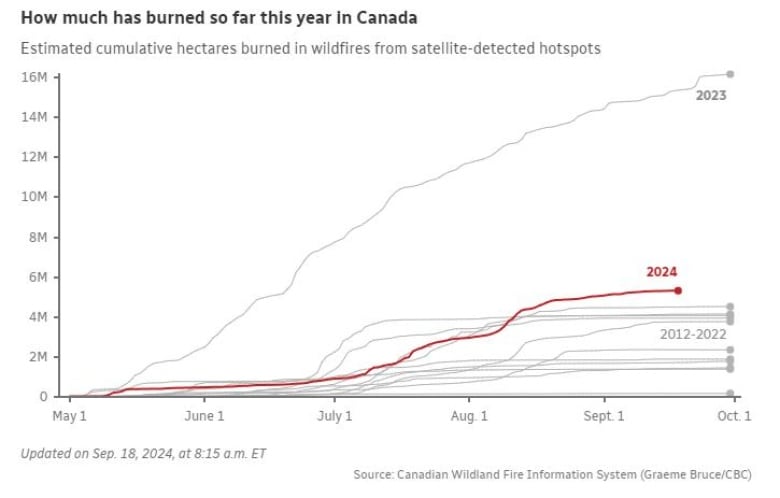

2023 was the worst wildfire season in Canadian history, burning 17 million hectares and releasing more carbon emissions than most top-emitting countries. In comparison, 2024 may have seemed quiet, with the exception of the blaze that devastated Jasper National Park and the nearby townsite. But it was actually the second-worst season (after 2023) since 1995 — and it’s not over. The image above is a recent screenshot from CBC’s Wildfire Tracker. Check it out to keep track of where wildfires are now, how much has burned in each province and air quality impacts in your community.
— Emily Chung
Hot and bothered: Provocative ideas from around the web




I’m a therapist. In helping people deal with their climate anxiety, I’m learning to manage my own


This First Person column is the experience of Amy Green, a registered psychologist who lives in Salmon Arm, B.C. All specific client stories and quotes have been used with their consent. For more information about CBC’s First Person stories, please see the FAQ.
“I’m doing a lot better this year,” Julie said when I asked how she’s coping this summer. “All the rain in June was a huge blessing.”
I’m a psychologist and Julie is a client in my private practice in Salmon Arm, a rural community in the southern Interior of B.C. Our August meeting was the latest in several sessions since she’d reached out to me a couple of years ago for help with her climate anxiety.
That anxiety ramps up each year during fire season.
“I’m just grateful I can attend my cousin’s wedding next weekend,” she added, her voice cracking.
“If there was a local fire right now and we were on evacuation alert, I wouldn’t be able to go. And that’s where the anxiety feels like it cripples me.”
Her words resonate with me more than she knows. Over the past few years, my own climate anxiety — a condition defined in The Handbook of Climate Psychology as heightened distress in response to the threat of climate change — has become at times all-consuming.
And I’m not alone. A recent summary of public opinion research showed most Canadians are worried about climate change and want governments and corporations to do more about it.
My anxiety sometimes becomes so heavy it’s suffocating. As a mom to three- and six-year-old daughters, I’m plagued by nagging questions.
If it’s 40 C in 2024, what will the forecasts of my kids’ future look like? Will they have clean air to breathe and fresh water to drink? Or will it be all famine, floods and water wars?
I also realize that, on a global scale, my carbon footprint is massive. I live in a large home — well above the average Canadian square footage — that we heat with natural gas. Although I’m limiting air travel now, I’ve already taken more plane rides than I could possibly count.
I feel infinitely guilty that those who’ve contributed the least to the climate crisis suffer the most.
In Canada, Indigenous communities make up 42 per cent of wildfire evacuations and experience disproportionate mental and physical health impacts. During last year’s Bush Creek East fire, which burned more than 45,000 hectares near Salmon Arm, 31 homes in the Skwlāx te Secwepemcúl̓ecw First Nation were lost.
We’re no strangers to forest fires in Salmon Arm, but the Bush Creek fire hit particularly close to home, as one client after another shared their stories of grief and loss. Some were forced to evacuate in truly terrifying conditions while others worked on the ground as first responders or behind the scenes in support roles.
A year later, I’m helping some of them slowly and carefully process their trauma.
We use therapies that help transform memories of flames and smoke into images that feel more distant and organized. Pervasive negative thoughts of “I’m in danger” shift into “It’s over now” and “I’m safe.” One client visualizes a powerful grizzly bear leading her to safety every time the flashbacks come.
More and more teens — anxious and angry about the climate mess they’re inheriting — are also landing in my office. Many think the future is frightening.
One of my teen clients told me she has come to dread summer break because of the ever-looming fire threat.
She worries about things like collapsing Atlantic Ocean currents, food security and Hajj pilgrims dying in scorching heat.
I asked how she copes with the anxiety.
“Mostly just distraction, I guess,” she shrugged.
“Maybe there are some other strategies,” I suggested gently.
You can read more about Amy Green’s strategies for coping with climate anxiety here.
Have a compelling personal story about climate change you want to share with CBC News? Pitch a First Person column here.
Stay in touch!
Thanks for reading. Are there issues you’d like us to cover? Questions you want answered? Do you just want to share a kind word? We’d love to hear from you. Email us at [email protected].
Sign up here to get What on Earth? in your inbox every Thursday.
Editors: Emily Chung and Hannah Hoag | Logo design: Sködt McNalty